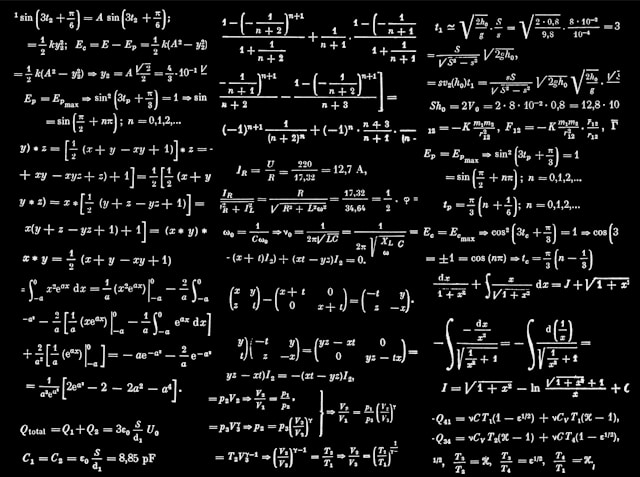Let’s get started on this exploration of Scientific Notation . It’s a fundamental concept, really, and one that unlocks a whole new level of understanding when you’re dealing with numbers. Whether you’re a student just starting out, or someone who’s been around the block a few times, getting a solid grasp of scientific notation will make your life much easier, especially in fields like science and engineering. So, let’s dive right in and unravel this powerful tool together.
Table of Contents
Understanding Scientific Notation Explained is key to handling both incredibly large and incredibly small numbers with ease. We’ll explore how it works, why it’s so important, and how to convert numbers back and forth. You’ll find that scientific notation simplifies calculations and improves readability, making it a universal language in many disciplines. So, let’s move forward, and by the end of this, you’ll be comfortable with scientific notation.
We also Published
Welcome to this detailed exploration of Scientific Notation . This fundamental concept is essential for anyone working with numbers, especially in scientific and technical fields. Whether you’re a student, a scientist, or just curious, understanding scientific notation will significantly enhance your ability to work with very large and very small numbers. Let’s dive in and unravel the mysteries of this powerful tool!
Understanding Scientific Notation
Scientific notation is a standardized way of writing numbers that are either too large or too small to be conveniently written in decimal form. At its core, scientific notation expresses a number as the product of a coefficient and a power of 10. This method simplifies calculations, improves readability, and ensures a universal understanding of numerical values across different disciplines. Imagine trying to represent the distance to a distant galaxy or the size of an atom using standard decimal notation; it quickly becomes cumbersome and prone to errors. This is where scientific notation shines.
The Basic Structure
The general form of scientific notation is ##a \times 10^b##, where ‘a’ is the coefficient (or significand), and ‘b’ is the exponent. The coefficient ‘a’ is a number greater than or equal to 1 but less than 10. This ensures that the number is always represented in a consistent and easily comparable format. The exponent ‘b’ is an integer that indicates the power of 10 by which the coefficient is multiplied. This exponent determines the magnitude of the number, whether it’s a large number (positive exponent) or a small number (negative exponent).
Illustrative Examples
Let’s consider some real-world examples. The distance from the Earth to the Sun, approximately 149,600,000 kilometers, is more elegantly expressed in scientific notation as ##1.496 \times 10^8## kilometers. Similarly, the mass of a hydrogen atom, about 0.00000000000000000000000167 kilograms, is written as ##1.67 \times 10^{-27}## kilograms. These examples highlight how scientific notation makes it easier to grasp the scale of these numbers and simplifies their use in calculations. The beauty of scientific notation lies in its ability to handle both extremes with equal ease and precision.
Why Scientific Notation Matters
Scientific notation is not just a convenient way to write numbers; it’s a fundamental tool that enhances clarity, simplifies calculations, and promotes standardization. In fields like physics, chemistry, and astronomy, where dealing with vast distances, tiny particles, and enormous quantities is commonplace, scientific notation is indispensable. Without it, scientists and engineers would struggle to communicate and perform calculations accurately. The benefits extend beyond mere convenience; it’s about precision, efficiency, and the ability to work with numbers that would otherwise be unwieldy.
Clarity and Convenience
One of the primary advantages of scientific notation is its clarity. It reduces the chance of errors caused by miscounting zeros or misplacing the decimal point. This is particularly crucial when dealing with experimental data or complex calculations. Furthermore, scientific notation simplifies mathematical operations. For instance, multiplying or dividing numbers in scientific notation involves simply multiplying or dividing the coefficients and adding or subtracting the exponents. This makes complex calculations much more manageable and less prone to errors. For example, consider ##(2 \times 10^4) \times (3 \times 10^3) = 6 \times 10^7##. This is much simpler than multiplying out the original numbers and then dealing with the resulting large number.
Standardization and Universal Understanding
Scientific notation provides a universally accepted method of representing numbers, which is critical in scientific research and communication. It eliminates ambiguity and ensures that researchers worldwide can understand and interpret numerical data consistently. This standardization is essential for collaboration, data sharing, and the advancement of scientific knowledge. Whether you’re reading a scientific paper, analyzing data from a space probe, or designing a new engineering project, scientific notation ensures that everyone is “speaking the same numerical language.”
Converting to and from Scientific Notation
The ability to convert between standard decimal notation and scientific notation is a critical skill. The process involves manipulating the decimal point and adjusting the exponent accordingly. Mastering this conversion allows you to seamlessly work with numbers in either form, depending on the context and the task at hand. Let’s explore the steps involved in both directions, ensuring you can confidently convert any number.
Converting from Standard Notation to Scientific Notation
Converting a number from standard notation to scientific notation is a systematic process that involves a few simple steps. The objective is to express the number in the form of \(a \times 10^n\), where \(a\) is the coefficient and \(n\) is the exponent. The coefficient \(a\) must be between 1 and 10, which frequently requires adjusting the original number by shifting its decimal point.
To begin the conversion, identify where the decimal point is located in the standard notation. If the number is a whole number, the decimal point is implicitly at the end of the number. For instance, if we take the number 4,500, the decimal point is situated after the last zero (4,500.0). If the number is a decimal, such as 0.0045, the decimal point is located at the beginning of the number.
The next step involves moving the decimal point to create a coefficient (\(a\)) that lies within the range of 1 to 10. In the example of 4,500, moving the decimal point two places to the left gives us 4.5. Therefore, we rewrite 4,500 as \(4.5 \times 10^2\). The exponent \(n\) is determined by counting how many places we moved the decimal point, which in this case is 2, as we shift left. Thus, the exponent is positive because we started with a large number.
Conversely, if the number is a decimal like 0.0045, we would move the decimal point two places to the right, turning it into 4.5, thus writing it as \(4.5 \times 10^{-3}\). The exponent is negative here to indicate that we are representing a fraction. This systematic approach allows for consistent and precise conversions from standard notation to scientific notation, facilitating easier comprehension and handling of very large or small numbers.
Scientific Notation Examples : Converting to Scientific Notation
- Convert 12345 to scientific notation: Move the decimal point to the left 4 places to get 1.2345.The exponent is 4 (since we moved it to the left). Scientific Notation: 1.2345 × 104
- Convert 0.000678 to scientific notation: Move the decimal point to the right 4 places to get 6.78.The exponent is -4 (since we moved it to the right). Scientific Notation: 6.78 × 10-4
- Convert 560000 to scientific notation: Move the decimal point to the left 5 places to get 5.6.The exponent is 5 (since we moved it to the left). Scientific Notation: 5.6 × 105
- Convert 0.00234 to scientific notation: Move the decimal point to the right 3 places to get 2.34.The exponent is -3 (since we moved it to the right). Scientific Notation: 2.34 × 10-3
- Convert 7890000 to scientific notation: Move the decimal point to the left 6 places to get 7.89.The exponent is 6 (since we moved it to the left) .Scientific Notation: 7.89 × 106
Converting from Scientific Notation to Standard Notation
Converting scientific notation back to standard notation is a fundamental skill that is essential for interpreting and presenting numerical data. Scientific notation expresses numbers as a product of a coefficient and a power of ten, making it easier to convey very large or very small quantities. The process of conversion involves determining the value of the exponent to shift the decimal point accordingly.
The first step is to identify the coefficient and the exponent in the scientific notation. The coefficient is usually a number between 1 and 10, while the exponent indicates how many places to move the decimal point. When the exponent is positive, it signifies a move to the right, which increases the value of the number. Conversely, a negative exponent indicates a move to the left, effectively reducing the number’s value.
For example, consider the scientific notation 3.5 × 10³. The exponent here is 3, which informs us to move the decimal point three places to the right, transforming it into 3500. Conversely, when converting a number like 2.1 × 10⁻², the exponent is -2. This means we move the decimal point two places to the left, resulting in 0.021.
It is vital to handle both positive and negative exponents properly. For instance, if converting 4.7 × 10⁵, you would shift the decimal point five places to the right, yielding 470000. In contrast, with a negative exponent such as in 5.0 × 10⁻¹, the decimal moves one place to the left, giving 0.5. Familiarizing oneself with these movements through various examples will significantly enhance comprehension, allowing for seamless conversions between scientific notation and standard notation.
Standard Notation Examples : Converting to Standard Notation
- Scientific Notation: 4.56 × 103 The exponent is 3, so move the decimal point 3 places to the right. Standard Notation: 4560
- Scientific Notation: 7.89 × 10-2 The exponent is -2, so move the decimal point 2 places to the left. Standard Notation: 0.0789
- Scientific Notation: 1.23 × 105 The exponent is 5, so move the decimal point 5 places to the right. Standard Notation: 123000
- Scientific Notation: 3.456 × 10-4 The exponent is -4, so move the decimal point 4 places to the left. Standard Notation: 0.0003456
- Scientific Notation: 9.01 × 102 The exponent is 2, so move the decimal point 2 places to the right. Standard Notation: 901
Additional Problems and Solutions
Here are some practice problems to solidify your understanding of Scientific Notation Explained and to test your skills in converting numbers to and from scientific notation.
Problem 1: Convert 2,500,000 to scientific notation
Solution: ##2.5 \times 10^6##
Problem 2: Convert 0.0000037 to scientific notation
Solution: ##3.7 \times 10^{-6}##
Problem 3: Convert ##4.8 \times 10^4## to standard notation
Solution: 48,000
Problem 4: Convert ##9.12 \times 10^{-3}## to standard notation
Solution: 0.00912
Problem 5: Multiply ##(2 \times 10^2) \times (3 \times 10^3)##
Solution: ##6 \times 10^5##
We also Published
RESOURCES
- Math Antics – Scientific Notation – YouTube
- Scientific Notation
- Scientific Notation – Explained! – YouTube
- Scientific Notation Definition
- Scientific notation – Wikipedia
- Scientific notation review (article) | Khan Academy
- How to Write Numbers in Scientific Notation | dummies
- 1.2: Scientific Notation – Mathematics LibreTexts
- Can someone please explain Scientific notation and how to …
- Scientific notation | Definition, Rules, Examples, & Facts | Britannica

